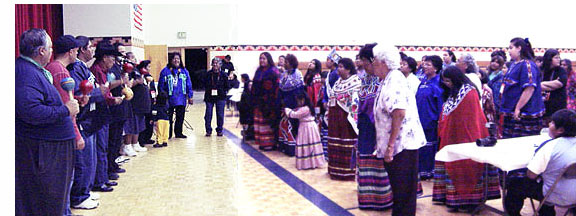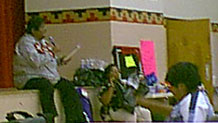
Your pictures here ! (Wait until we get your pictures. Then it will be active!) Thank you for your contribution. Mehan!
Over on the Colorado River this spring we were gathering again. We are there with a sense of community. Yuman Language is a large, diverse, rich in tradition family. The most widely accepted classification of Native American languages North of Mexico (although some included are also spoken in Mexico and Central America) is that made by Edward Sapir in 1929. Sapir arranged the numerous linguistic groups in six major unrelated linguistic stocks, or families. There are many native speakers that would agree that the general term, PAI, will reflect the logical relationships of the different Tribal Nations. It is with a real sense of belonging, at this time and in this place that Elders, organizing committee and tribal members came together this weekend.
We have some pictures of the cultural events and the Elders banquet to share. We saw many flashes and digital cameras at the conference. Please scan or download a copy of your pictures of the conference to assemble into a digital scrapbook of memories. Send E-mail or CD by postal mail.
One of the writers for the San Diego Union-Tribune wrote a story of the event too. It is included below. Finally, if you have other stories or viewpoints you would like to share please forward those to the same E-mail address. Mehan, Aho, thank you.
Roy Cook: Committee Member

Quechans
Getting Creative to Help Keep Their Language Alive
BY PAIGE
LAUREN DEINER
Apr 2, 2005
Susie Gilbert is learning Quechan for her husband. Once she's mastered the language, she plans to teach it to her husband, a Quechan who never learned his native tongue. "I am doing this to give something back to my husband. It's his language. It's my gift to him," Gilbert said.
Gilbert has a common goal with the people who turned out Friday at the Yuma Civic and Convention center for the fourth annual Yuman Family Language Summit sponsored by the Quechan Indian tribe, the theme of which is "e-yah ny aam pii pik" — Language is Our Survival.
The goal of the conference, which began on March 21 and ends today, is to promote and educate attendees about lan- guage and cultural preservation through different projects undertaken by the 17 Yuman tribes from Arizona, California and Mexico. The projects ranged from teaching language and culture through games and arts and crafts to creating oral history movies and computer software to learn native languages.
Gilbert said in an interview with The Sun that she began taking classes this year with Barbara Levy, a Quechan language teacher in Yuma, but the schedule is somewhat irregular because Levy does not have a classroom or a regular meeting place. Students gather at Levy's house at night, or meet under the trees on the Fort Yuma reservation. Still, students manage to meet with Levy about three times a week to learn about their culture, language and hear stories that elders once told, said Gilbert, who gave a presentation with Levy about Quechan language learning during the summit.
Levy has been teaching the class for four years, while at the same time participating in another project to keep the Quechan language alive. That project, also discussed at the summit, involves developing an English-to-Quechan dictionary to enable people to look up and learn Quechan words and phrases. The project began more than 70 years ago, when linguist Abraham Halpern came to study the Quechan language. He stayed with the Quechans off and on for three years, writing down words and figuring out the grammatical structure of the language, said Amy Miller, who is creating the dictionary.
The time lapse occurred because Halpern became involved in other projects and did not return to the Quechan reservation until his retirement in 1975. Then he began to record the language and stories of the elders, who feared that without some sort of record their language and culture might be lost, said Miller, who has spent the last seven years trying to finish the dictionary Halpern started.
She is working with Levy and with 84-year-old George Bryant of Yuma, who grew up speaking Quechan and didn't learn English until he started school, to develop the dictionary. Miller said the project has taught her "how beautiful and complex the Quechan language is." She said creating a dictionary for the Quechan language is sometimes complicated because it has 38 sounds, many of which are not found in English. So far the dictionary has 3,964 words, about 800 contributed or verified by Bryant. The first word in the sample dictionary Miller provides was 'axakatom paa'aw, a hippopotamus. The word is used as a common phrase said jokingly about a large person swimming, according to Miller's dictionary. 'Axakatom paa'awets veeyemk is the phrase meaning "there goes a hippo."
Bryant said this
dictionary will allow people "to keep a record of our language."
"All we know is that we talk the language and what we say makes sense,"
said Levy. She added that she was reluctant to get involved with the project
at first because she felt she wasn't old enough, but decided that since
she grew up speaking Quechan, she could be helpful to Miller. Provided
that no other words are discovered, Miller said the dictionary will take
more than two years to compete. "It seemed like a job that would
never be completed, but I see an end coming. I hope schools will computerize
all these systems into one big system while we still have people who know
the language — I think it's a good thing to know," said George
Bryant.

Tribal Delegates
Gather to Talk About Saving Their Language
By Chet Barfield, STAFF WRITER
In a conference hall echoing with chanted songs almost as old as the nearby Colorado River, hundreds of American Indians are rekindling a fundamental flame of their diverse but related cultures. They're trying to save their language.
About 300 tribal delegates from Southern California, western Arizona and northern Mexico are here to help revive and sustain the Yuman language, the root of dialects spoken by the Kumeyaay, Cocopah and more than a dozen other tribes from the Grand Canyon to the Pacific Ocean.
These are oral languages with no alphabet. Elders who grew up with them are dying off. And kids on reservations today have many other influences. "We realize we're just a generation away from our languages becoming extinct," said Emilio Escalanti, councilman for the Yuma-area Quechan tribe and a coordinator of this week's fourth annual Yuman Family Language Summit. "What makes us Quechan (pronounced KWUT-san) is our Quechan language," he said. "Otherwise we would be like Joe Public. But we're not. We were created to be here, in this spot in the world.'"
At the three-day conference, which ends today at the Yuma Civic and Convention Center, participants are sharing songs, dances and stories. They're weaving grass baskets and bark skirts. And they're learning innovative ways, new and old, that native language can be restored in their communities.
It might be with a computer video of an elder singing a song, with scrolled words that can be clicked to display pronunciation and definition. Or, as the Grand Canyon-area Hualapais are doing, it can be done through traditional games dating back hundreds of years. Tribal groups are creating words for things that didn't exist in aboriginal times. The Hualapai word for computer, says elder Lucille Watahomigie, is derived from "metal thing where you store writing."
Indians must walk in both worlds, ancient and modern, said Cheryle Beecher, a Hualapai family-services worker. "Things are changing. Our language is changing," she said. "We need to hold onto our culture and teach our children that way."
Indian gaming helps and hinders. Casino proceeds fund cultural-enrichment programs and pay expenses for delegates to attend conferences such as this. At the same time, soaring profits are pushing some tribes more and more toward capitalistic values and away from their roots. A cultural historian at Barona, Larry Banegas, says it's hard to get more than 10 to 12 tribal members in his Kumeyaay language classes. "They're too busy, off looking at other things," he said.
Since the arrival of Europeans, natives have struggled to maintain identity while pushed to assimilate. Until recent decades, Indian children were sent to boarding schools, stripped of their language and rituals. Today, leaders say, external forces on tribal youth are less blatant but just as strong: party drugs, popular music, the Internet, consumerism. "They're pressured with things that are not part of our tradition," said Edmund Domingues, vice chairman of the Cocopah tribe southwest of Yuma. "Our language," he said, "is what establishes ourselves as Cocopah. This is what establishes us as unique.
